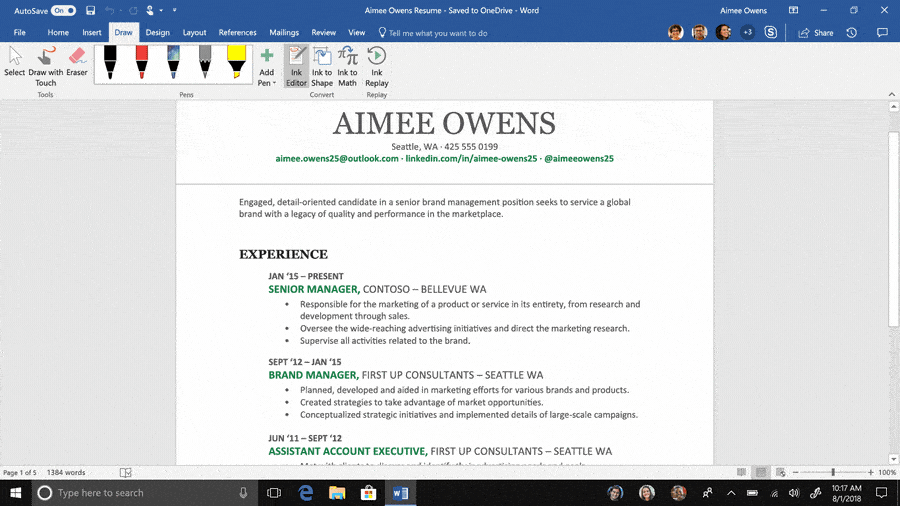| 2014 |
Exam Ref 70-346 Managing Office 365 Identities and Prepare for Microsoft Exam 70-346, and demonstrate your real-world mastery of the skills needed to provision, manage, monitor, and troubleshoot Microsoft Office 365 identities and cloud services.
Word transcribes in the background as you record; you won't see text on the page as you would when dictating. You'll see the transcript after you save and transcribe the recording. Make sure you’re signed in to Microsoft 365, using the new Microsoft Edge or Chrome. Get commonly used Office features and real-time coauthoring capabilities through your browser. Use Word on Office.com. 6 ways to successfully run your homebased business. Microsoft Word with a Microsoft 365 subscription is the latest version of Word. Previous versions include Word 2016, Word 2013, Word 2010, Word 2007.
A template is simply a starting point. A Word (or any other Office) template is something that you create once that can be used over and over again. To create a template, you can start with a document you already created, one you downloaded, or a brand new one that you decide to customize in any number of ways.
To save a document as a template, click File > Save As.
Double-click This PC.
Type a name for your template in the File name box.
For a basic template, click Word Template in the Save as type list.
If your document contains macros, click Word Macro-Enabled Template.
Word automatically goes to the Custom Office Templates folder.
What is the photo on desktop for mac catalina. Click Save.
Tip To change where Word automatically saves your templates, click File > Options > Save and type the folder and path you want to use in the Default personal templates location box. Word will save any new templates in that folder, and when you click File > New > Personal, Word will show you the templates in that folder.
Edit your template
To update your template, open the file, make the changes you want, and then save the template.
Click File > Open.
Double-click This PC.
Browse to the Custom Office Templates folder that’s under My Documents.
Click your template, and click Open.
Make the changes you want, then save and close the template.
Use your template to make a new document
To start a new document based on your template, click File > New > Personal, and click your template.
Word Office 365 Psu
Use your templates from earlier versions of Word
If you made templates in an earlier version of Word, you can still use them in Word 2013. The first step is to move them into the Custom Office Templates folder where Word can find them.
Word Office 365 App
-->Note
Office 365 ProPlus is being renamed to Microsoft 365 Apps for enterprise. For more information about this change, read this blog post.
Note
This article only addresses the crash scenario where mso30win32client.dll is the module name in a crash signature.
For other scenarios, see the following articles:

If you still couldn't find a solution with Office Applications crashing or not starting, you might check the Microsoft Community Office Commercial Admin Center Forums.
Symptoms
Microsoft Office 2016 applications may crash or cannot start. The applications that have been seen to be affected are Excel, Outlook, Skype for Business, Word, Access, Publisher, Project and OneNote.

Additionally, in the Application Event log, you may find a crash signature similar to the following in event ID 1000:

Note
- The Application Name will be the name of the executable of the application, such as excel.exe, outlook.exe, lync.exe, winword.exe, msaccess.exe, mspub.exe, winproj.exe, or onenote.exe.
- The Application Version, Module Version and Offset will vary.
Workaround
Important
Follow the steps in this section carefully. Serious problems might occur if you modify the registry incorrectly. Before you modify it, back up the registry for restoration in case problems occur.

Office 365 Word Online
To work around this issue, follow these steps:
Word Office 365 Microsoft
Exit all Office 2016 applications.
Start Registry Editor. To do this, use one of the following procedures, as appropriate for your version of Windows.
- Windows 10, Windows 8.1 and Windows 8:Press Windows Key + R to open a Run dialog box. Type regedit.exe and then press OK.
- Windows 7: Click Start, type regedit.exe in the search box, and then press Enter.
Locate and then select the following registry key:
HKEY_CURRENT_USERSoftwareMicrosoftOffice16.0CommonGeneral
Locate the ShownFirstRunOptin registry value in the key that is specified in step 3. If you do not find ShownFirstRunOptin, go to step 5. If you do find it, go to step 7.
If you do not find the ShownFirstRunOptin registry value, point to New on the Edit menu, and then click DWORD (32-bit) Value.
Type ShownFirstRunOptin, and then press ENTER.
Right-click ShownFirstRunOptin, and then click Modify.
In the Value data box, type 1, and then click OK.
On the File menu, click Exit to exit Registry Editor.
